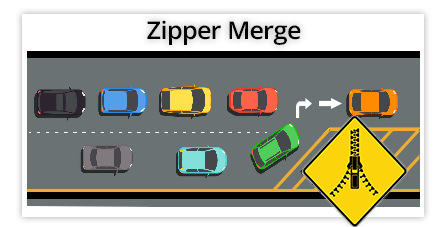How to Merge Into Traffic
Merging can be intimidating for new drivers, but it doesn't have to be! Here's our guide to safe and legal merging.
What is merging?
What is merging when driving? Whenever you enter traffic, whether you’re going straight through an intersection, turning onto a different road, or backing out of a driveway, you need plenty of room to safely join, or merge, with other roadway users. Merging requires you to watch traffic until there's a big enough gap between vehicles and that you have enough time and space to join traffic without colliding with another vehicle or slowing everyone else down.
 Merge Sign
Merge Sign
How to Select a Sufficient Gap in Traffic
The size of the gap needed in order to merge safely varies based on the environment. Going straight through an intersection from a stop will take less time than making a right turn and then accelerating to keep pace with traffic. Turning right will take less time than backing out of a driveway and then shifting the vehicle from “Reverse” into “Drive”. So, you’ll need increasingly bigger gaps for each of these scenarios.
Speed will also play a part in determining what a sufficient gap is. The faster a vehicle is moving, the bigger your gap needs to be. So, in order to make a right turn when traffic is traveling at 20 miles per hour, you would need a gap more than half a block long. To make a right turn when traffic is traveling at 44 miles per hour, you would need a gap more than two blocks long. When approaching vehicles are traveling at higher speeds, they will pass you quicker than they would at slower speeds.
To determine the speed of oncoming traffic, start counting from the moment you first see an oncoming vehicle to the moment that vehicle passes you (e.g., one thousand one, one thousand two, etc.). You need about six seconds to cross traffic, eight seconds to make a right turn and join traffic, and nine seconds to make a left turn and join traffic.
If you're on the fence about whether or not there's enough space to merge, don't risk it. Wait a few extra seconds until you're positive you'll be able to merge safely.
How to Merge on Multi-Lane Roads
On a roadway with three or more lanes all heading in the same direction, a vehicle entering a lane of traffic from a lane to the right must always yield the right-of-way to a vehicle entering the same lane of traffic from a lane to the left.
Here’s how that plays out. If you’re driving in the far-right lane of a three-lane highway like I-65 and want to merge into the middle lane, you must first check that no vehicle from the far-left lane is merging into the middle lane. If there’s a car in the far-left lane that is clearly merging into the middle lane (right turn signal flashing, moving to the right), then you must wait for that car to safely enter the middle lane first. Once that car has completed merging into the middle lane and has moved far enough ahead, you can move into the middle lane (as long as no other cars are approaching).
Unfortunately, not everyone uses their turn signals when merging on three-lane highways, so you must be very cautious when merging into the middle lane. It’s not enough for just the middle lane to be clear; make sure no one else is trying to merge into the same lane at the same time as you.
Zipper Merging
When traffic is super congested and there isn’t an open gap in traffic to easily merge into, traffic can get backed up and come to a dead stop. This is a recipe for road rage as it can be really frustrating when you're unable to merge or when other drivers switch lanes unexpectedly. In this case, it's best to use a zipper merge pattern.
 Zipper Merge
Zipper Merge
A zipper merge is when drivers stay in their lane until the point of lane closure. At that point, drivers take turns merging with every other car in a zipper fashion. This helps reduce sudden lane changes and makes it so everyone is driving at the same speed, rather than one lane traveling much faster than the other one. Keep an eye out for signs that tell you to use a zipper merge pattern.
Keep in mind that some drivers will still chose to ignore the courtesy of zipper merging. Make sure you're always alert and be ready to stop if needed.